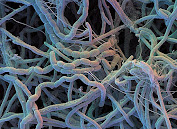Bizarre First: Viruses Seen 'Biting' Onto Other Viruses Like Tiny Vampires
(Click images to enlarge)
Viruses can't live on their own. They are hunks of DNA or RNA packaged in some kind of protein compartment just waiting to bump into cells that they can infect. Those can be human, animal, plant, or bacterial cells. After they attach, they insert their genetic material into the cell and use its machinery to make copies of the virus. Now, we have evidence of a virus attaching to another virus to help it spread its DNA/RNA, and some researchers are calling this a "vampire virus".
The word bacteriophage (or just phage) is used to describe a virus that infects bacteria. Small as bacteria are, viruses are even smaller, and they require the enzymes in bacteria to build copies of themselves. They come in various shapes, looking like a polygon, a filament, a blob, or a lemon, but the most commonly shown in news is the one that has a capsule-like head on top of a tail which has some leg-like fibers to help it attach to bacteria.
But there are some viruses that can't attach to cells and need another virus to help them do that and to enter a cell. They also need the DNA/RNA of the other virus to provide instructions on how to make its own protective capsid. They latch on to the "helper virus", give it its genetic material, and the helper virus does the rest when it infects a cell with both sets of DNA/RNA. These incomplete viruses dependent on others are called satellite viruses.
Researchers from the University of Maryland Baltimore County (UMBC) have just discovered a satellite virus that attaches to one type of bacteriophage, and even though the biological term for its attachment location is the tail of the phage, they described it as the neck. This led them to name the satellite virus a "vampire virus". After it broke free, the legs were still attached and resembled bite marks.
Undergraduate students were studying environmental samples as part of a routine project at UMBC. Streptomyces bacteria are very common in soil, and they knew there were likely some bacteriophage against it in their samples. Usually, they find bacteriophages from such samples, send them to another lab to analyze what the DNA or RNA sequence looks like (what genes the phage it has), and then study the results back at UMBC.
They already knew the gene sequence for a phage that they suspected was in the soil sample, but the lab told them that it must have been contaminated because it had other genes in it, not just the ones from the phage. The students got a head teacher to prepare the samples next, but the lab got the same results, so everyone figured there had been no mistake, no contamination. Where did the unusual bits of DNA come from?
UMBC happens to have an imaging facility with very high-tech instruments. So, they sent their samples there to see (literally) what could be seen under an electron microscope. Normal microscopes have a magnification power around 1000x, but electron microscopes go much further, up to several millions of times.
The imaging facility assistant director Tagide deCarvalho was amazed at what she saw. About 80% of the helper phage had a satellite attached to its tail, just under the head-like capsid. Some of the phage that didn't have them showed fragments of the satellite virus attachment fibers clinging to it, and students describe them as the "bite mark" of this vampire satellite virus on the helper phage.
Hepatitis D virus is a satellite virus and can only infect human cells when hepatitis B virus is present. Together, they cause a "super-infection" that causes the liver to fail. Another real satellite virus is the one infecting tobacco, causing reduced crop yields, stunted growth, and plant death. Understanding more about vampire viruses might help our understanding of medical and agricultural conditions like this and how to treat or prevent them. How many other situations have given what people thought were contamination but instead were satellite viruses?





No comments:
Post a Comment